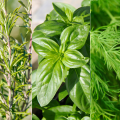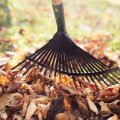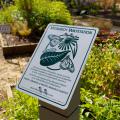Growing Herbs
Herbs in the Garden
Herbs are a special group of plants used for flavoring and scents. Many herbs used in flavoring foods and teas (culinary herbs) can be grown in Mississippi gardens. Most herbs should be grown in full sun, but a few tolerate light shade. They prefer a well-drained soil of medium fertility with a pH of 6.0 to 7.0. An organic mulch in summer benefits the plants.
Herbs that can be grown in Mississippi are annuals that are planted every year, biennials that are planted in the fall and flower the following year, hardy perennials that come back year after year, and tender perennials that may survive a mild winter but often need to be treated as annuals or protected from freezing temperatures.
You can start most popular herbs from seeds. Many of the perennial herbs are propagated by stem cutting, layering, or crown divisions. Annual, and some perennial, herb plants are sold at nursery and garden centers, and seeds and plants are offered by many mail order catalog companies.
Because herbs are used in very small amounts, just a few plants of each type may be enough. If you want a large quantity of a particular herb, such as sweet basil for making pesto, plant the herb in the vegetable garden. Otherwise, prepare a small area especially for herbs so that they can be enjoyed for their appearance as well as fragrance.
Herbs have few pests, which is good because there are few if any pesticides approved for use on these plants. When planting herbs in the vegetable garden, protect them from pesticides used on vegetables.
Grow herbs started from containers so they can be set in the garden without disturbing the roots. Borage and dill are two herbs that do not transplant well if bare-root. Either scatter seeds in the garden where these herbs are to grow, or start plants in containers.
The flavors and scents of herbs are caused by oils in the plant tissue. High fertilization, excess moisture, and shade result in low oil content and weak flavor. The oil content in many herbs is at its highest just before the plants begin to flower.
Herbs and Their Characteristics
Anise—annual grown for its licorice-flavored leaves and seeds; slow growing; difficult to transplant bare-root.
Basil—annual grown for its leaves; available in several different flavors and plant types; easily gown from seed; purple leaf types make attractive vinegar.
Sweet Bay—tender perennial, evergreen shrub; source of bay leaf; requires cool greenhouse protection in winter; frequently grown as a container plant; start with a nursery-grown plant.
Bergamont—perennial, also known as bee balm; grown for minty leaves; attractive flowers attract bees and hummingbirds; start from crown division or seeds.
Borage—annual grown for cucumber-flavored leaves and attractive small blue flowers; attracts bees; makes a large, unruly plant; difficult to transplant bare-root.
Salad Burnet—perennial grown for cucumber-flavored leaves; grow from seed or crown division.
Catnip—perennial grown for leaves; a mint; grow from seed, cuttings, or division.
Chamomile—perennial grown as annual; flowers used for tea; grow from seed.
Garlic Chives—grown for leaves with light garlic flavor and scent; grow from seed or division; attractive white flowers sew many seed; self-seeds prolifically.
Onion Chives—perennial grown for onion-flavored leaves; attractive purple flowers; grow from seed or division.
Coriander—annual; grow from seed; fresh green leaves known as cilantro and Chinese parsley; also grown for seeds.
Costmary—perennial; known as bible leaf; grown for minty scented leaves; grow from seed or division.
Dill—annual grown for seed heads and leaves; prefers cool weather; grow in spring and fall; doesn’t transplant well bare-root; scatter seeds where plants are to grow or use container-grown plants.
Garlic—perennial grown for dry bulb; plant garlic cloves in October and harvest bulbs in May and June.
Scented Geraniums—tender perennials; available in many different scents: rose, peppermint, lemon, lime, orange, strawberry, apple, almond, mint; variety of foliage forms available; excellent pot plant; propagate by cuttings.
Ginger—tender perennial grown for pungent root; treat as annual (plant in spring and harvest in fall); propagate by root cuttings; prefers moist, rich soil.
Anise Hyssop—perennial grown for licorice flavored leaves for teas; attractive purple flowers attract bees; a mint; propagate by seed or division.
Lemon Balm—perennial mint grown for lemon-scented leaves; grow from seed, division, or cuttings.
Lemongrass—tender perennial grown for lemon-flavored leaves used in oriental cooking; attractive as ornamental grass with blue-green color; leaves have sharp edges.
Lemon Thyme—perennial; low-growing attractive plant for sunny area; leaves have strong lemon fragrance.
Marjoram—perennial grown as annual; grown for leaves; grow from seed, cuttings, or by layering.
Mint—perennial; many different flavors and leaf and plant types; spreads rapidly; prefers moist soil, tolerates shade; keep cut for tender growth.
Oregano—perennial grown for leaves; grow from seed, cuttings, or division.
Parsley—biennial grown as annual; grown for leaves; grow from seed; prefers moist soil.
Rosemary—perennial, evergreen shrub but reliably hardy; grown for leaves; available in different plant types, upright and creeping; adapted to pot culture; prefers moist, well-drained soil.
Sage—perennial grown as annual, not reliably hardy; available as common, golden, and variegated; grown for leaves; grow from seed, cuttings, or layering; prefers well-drained soil.
Pineapple Sage—tender perennial; pineapple-scented leaves; large plant; attractive red flowers grow from cuttings.
Summer Savory—annual grown for leaves; grow from seed; unruly plant.
Winter Savory—perennial grown for leaves; grow by layering; a neater plant with better flavor than summer savory.
Tarragon—perennial grown for licorice-flavored leaves; French Tarragon the only type to grow and only grows from stem and root cuttings; suffers with summer heat.
Winter Tarragon—tender perennial, not reliably hardy; also known as mint marigold; licorice-flavored leaves; propagate by cuttings and division; small single, orange, marigold-type flower in fall.
Thyme—perennial, but not reliably hardy; variety of flavors and plant types; grown for leaves; propagate by seed, cuttings, or divisions; prefers well-drained soil.
Lemon Verbena—tender perennial, shrubby, grown for leaves; propagate by cuttings; grow in container and provide winter protection.
Publications
News
Many herbs are easy to grow in the garden or in containers. Rosemary, basil, and dill are mainstays in my garden because I like to use them while cooking in my kitchen.
RAYMOND, Miss. -- Gardeners who want to preserve their abundant harvests by canning should make their list and check it twice -- now, before it’s time to begin canning. Home canners should be sure they have the right recipes and equipment for the foods they intend to preserve. They should also make sure they inspect all their equipment.
Autumn is officially here! It’s not hard to love this time of year. Temperatures are cooling, leaves are changing, and there will be more branches than foliage soon. It’s hard not to love this time of year! As we close out this calendar year, it’s easy to convince yourself there’s not much to do in the yard. Take a break, but also take time to check off these tasks
Success Stories
Paul Cavanaugh became a Master Gardener when he came off the road as a truck driver and his wife encouraged him to find a hobby.
As Jimmy Henry’s health began to decline, his wife, Shirley, wanted him to remain comfortable, safe, and happy. When the time came for Jimmy to enter a nursing home, Shirley was determined to stay right by his side, so she went with him.
See what's new in Extension: a new monarch garden, a storytelling series will begin, the Garden Expo highlights Extension education, and Keep America Beautiful recognizes MSU Extension.






